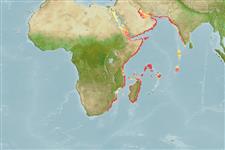Environment: milieu / climate zone / depth range / distribution range
Écologie
marin démersal; profondeur 0 - 2 m (Ref. 122824). Tropical; 30°N - 30°S, 31°E - 67°E
Western Indian Ocean: from Egypt, Suez, south to northern Durban South Africa and east to Pakistan. Migrated to the Mediterranean through the Suez Canal (Ref. 5385, 93646).
Taille / Poids / Âge
Maturity: Lm ? range ? - ? cm
Max length : 9.5 cm TL mâle / non sexé; (Ref. 127374); poids max. publié: 20.00 g (Ref. 127374)
Life cycle and mating behavior
Maturities | Reproduction | Spawnings | Egg(s) | Fecundities | Larves
Eschmeyer, W.N. (ed.), 2003. Catalog of fishes. Updated database version of March 2003. Catalog databases as made available to FishBase in March 2003. (Ref. 46206)
Statut dans la liste rouge de l'IUCN (Ref. 130435)
Menace pour l'homme
Harmless
Utilisations par l'homme
Outils
Articles particuliers
Télécharger en XML
Sources Internet
Estimates based on models
Preferred temperature (Ref.
123201): 24.6 - 27.6, mean 26.8 °C (based on 122 cells).
Phylogenetic diversity index (Ref.
82804): PD
50 = 0.5000 [Uniqueness, from 0.5 = low to 2.0 = high].
Bayesian length-weight: a=0.01122 (0.00528 - 0.02384), b=3.10 (2.92 - 3.28), in cm total length, based on LWR estimates for this (Sub)family-body shape (Ref.
93245).
Niveau trophique (Ref.
69278): 3.4 ±0.5 se; based on size and trophs of closest relatives
Résilience (Ref.
120179): Haut, temps minimum de doublement de population inférieur à 15 mois (Preliminary K or Fecundity.).
Fishing Vulnerability (Ref.
59153): Low vulnerability (10 of 100).
